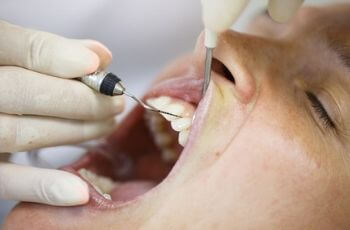
It’s best to contact our practice at the first sign of gum problems.
Then you may suffer from receding gums, exposing the softer part of your teeth below the gum line.
Periodontal disease is the most common cause of gum recession. That’s when plaque builds up on teeth producing gingivitis, leading to periodontitis. Gums recede in reaction to the acids produced by the bacteria in plaque. Neglected long enough the receding gum line gradually exposes tooth roots.
Some people may inherit thinner gum tissue. Or there may be other factors that make them more prone to receding gums. Besides being able to see the exposed tooth root, there is often increased sensitivity to hot or cold.
Gum surgery may be necessary to protect your teeth and avoid bone loss.
Gum Tissue Grafting
All surgeries come with risk. However, a gum graft is a relatively simple procedure in which healthy tissue is harvested from the roof of the mouth and sutured onto existing gum tissue.
There are several different types of gum grafts. The one that is appropriate for you requires a professional evaluation:
- Connective tissue graft. This is the most common, taking tissue from the roof of your mouth and stitching it over the exposed root. The goal is to obtain a good tissue blend while reducing sensitivity to hot and cold.
- Gingival graft. Similar to the connective tissue graft, the intent is to increase the amount of tougher gum tissue around a tooth. This helps reduce the likelihood of further recession.
- Pedicle graft. Instead of using tissue from the roof of your mouth, the pedicle graft uses tissue found adjacent to the tooth to perform the graft.
Protecting the Harvest Site
Before the surgery a stent is created to protect the tissue donor site during the healing process. It’s a retainer-like piece of plastic to protect the roof of your mouth while you’re eating. This preoperative cast is usually a thermoplastic material that conforms to the roof of your mouth.
After Your Surgery
Depending on the sedation used, you may want to make arrangements for someone to drive you home.
When the an[e]sthetic wears off, the wound on the roof of your mouth will feel similar to the burn from hot pizza. Thankfully, it tends to heal quickly. A prescription or non-prescription pain reliever should keep you comfortable during the recovery process.
You’ll receive specific postoperative care directions regarding diet, brushing and flossing and permitted physical activities. Be sure to stock up on soft foods such as eggs, pasta, gelatin, cottage cheese, pudding, well-cooked vegetables and ice cream.
It may take a week or two for your mouth to fully heal. Most patients can return to work and assume normal activities within a day or two.
Preventing the Need For Surgery
Treating gum recession with surgical grafts can be highly effective. Detecting and correcting the need for a surgical solution is the ideal strategy. That means regular brushing and flossing and periodic professional cleanings.
Is it time for your checkup? Give us a ring and let’s get you on the schedule.

